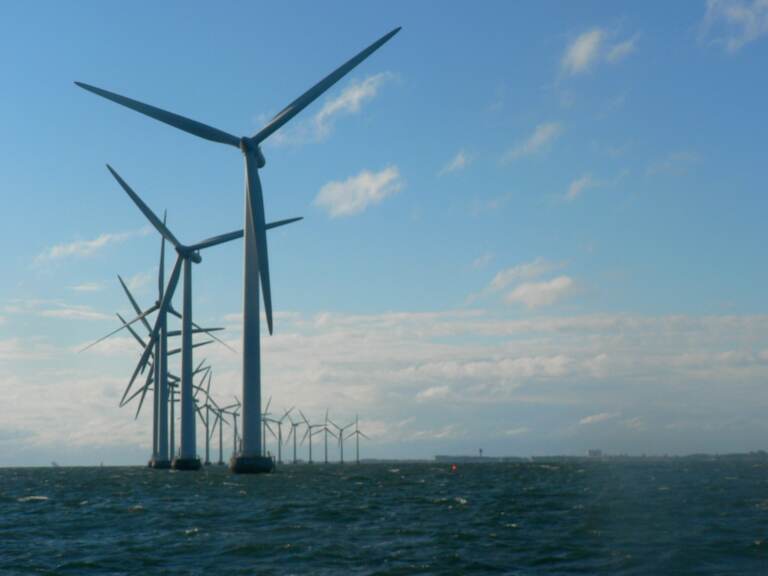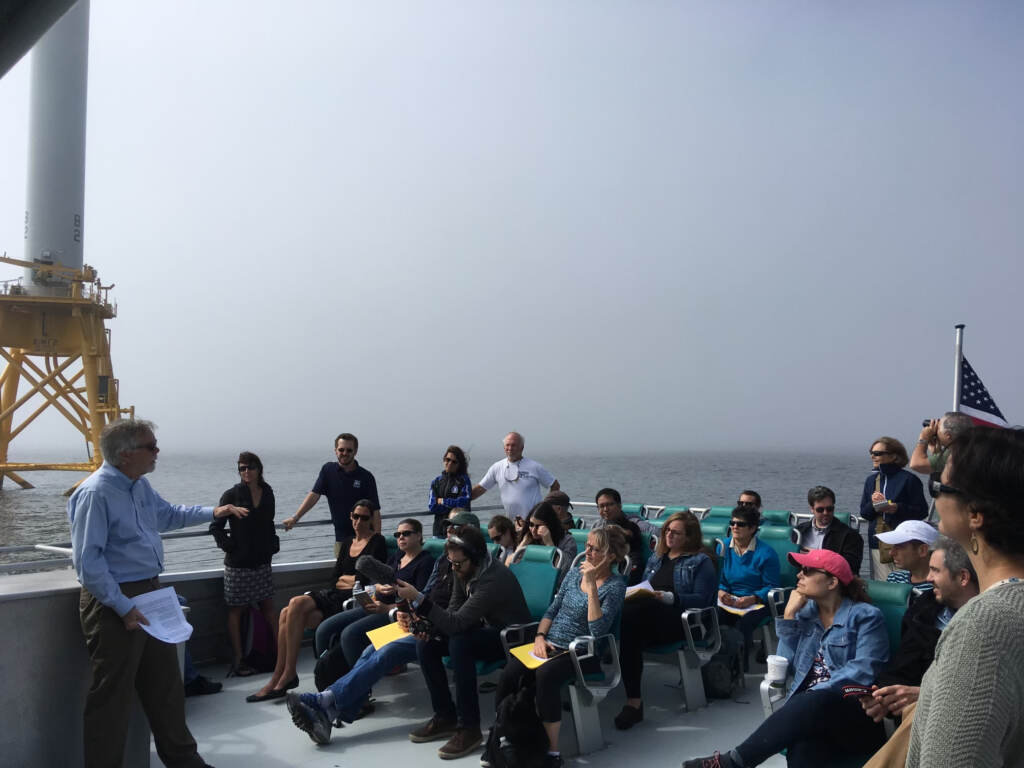‘The process is rolling’: Delaware takes 3rd look at procuring offshore wind power
A 2008 contract that would have made Delaware a pioneer in offshore wind evaporated. A 2018 study cited high costs, but a new law has the state pursuing the notion again.
Listen 1:54
Advocates in Delaware are hoping for something like this offshore wind farm off the coast of Copenhagen, Denmark.
This story is part of the WHYY News Climate Desk, bringing you news and solutions for our changing region.
From the Poconos to the Jersey Shore to the mouth of the Delaware Bay, what do you want to know about climate change? What would you like us to cover? Get in touch.
Delaware is taking its third swing in 15 years at getting a dedicated amount of its electricity from offshore wind farms, and advocates hope this time is the charm.
The first attempt came in 2008, when Bluewater Wind planned to construct up to 150 wind turbines about 13 miles off the Delaware coast. Bluewater had a 25-year contract to provide the state’s largest utility, Delmarva Power, with electricity.
But the deal that would have made Delaware the first state with an offshore wind farm collapsed in 2011, in large part because financing evaporated amid concerns over the high price of wind power.
The notion was resurrected in 2017, however, when Gov. John Carney took office and appointed a task force to evaluate the potential for offshore wind in Delaware. That group ultimately determined in a June 2018 report that the cost of wind power was still too prohibitive to make a project feasible.
But now, with every other East Coast state from Massachusetts to North Carolina involved in a wind project, Delaware is once again exploring the idea. This month, as part of a package aimed at reducing carbon dioxide emissions, Carney signed into law a measure that sets Delaware on another potential offshore wind path.
Citing the detrimental effects of global warming on the coastal state with the nation’s “lowest mean elevation,” the bill that passed overwhelmingly directs the state to study the transmission impacts of offshore wind development, work with neighboring states on the issue, prepare a procurement process, and issue a report by year’s end.
“This is a wonderful, wonderful start. And so we do feel optimistic,’’ said Peggy Schultz of Delaware POWER, which is an acronym for People for Offshore Wind Energy Resources. The coalition group includes the Sierra Club and Delaware Nature Society.
Schultz said last month’s announcement that the federal government had designated about 102,000 acres located 26 nautical miles off Delaware’s coast for possible wind farms could be the catalyst that spurs Delaware to finally act.

“We’re counting very, very heavily on the possibility, on the opportunity to pass a procurement bill” after lawmakers reconvene in January, Schultz said. “We feel as though there’s a real fervor in the House and the Senate for doing something about offshore wind.”
The proposed leasing areas off the coasts of Delaware, Maryland, and Virginia are part of the Biden Administration’s push to generate 30 gigawatts of offshore wind energy by 2030 – enough to light up 10 million homes.
President Biden visited the Philly Shipyard last month to promote offshore wind development in the region, including the construction of a new ship designed to help build the wind farms.
“Our Investing in America agenda is bringing our clean energy supply chains home,” Biden told the crowd of union workers and supporters. “Across the Delaware River in Paulsboro, New Jersey, workers are rolling the steel foundation for another large-scale wind project.”
While the federal government auctions off the lease areas, the states regulate the power contracts.
A bill in the General Assembly to codify a procurement process in Biden’s home state would be a critical step, but only one of dozens that would take several years.
They would include:
- Leases being awarded by the U.S. Bureau of Ocean Energy Management (BOEM) to wind turbine developers at new or existing sites.
- A copious permitting process before construction could begin.
- Delaware forging a partnership with Delmarva Power and/or the other smaller utilities serving Delaware to bid for some of the wind energy created at an offshore wind farm.
- Winning the bid in competition with other states that might want the power.
- Constructing a pipeline under the ocean floor that would connect to Delaware power facilities such as the Millsboro coal plant that’s being phased out of production.
Willett Kempton, a University of Delaware professor, was the lead author of a 53-page report in February 2022 by the independent Special Initiative on Offshore Wind, which concluded that the current cost of “offshore wind power prices fall within the range of wholesale power being purchased for Delaware now.”
Kempton, who co-founded the university’s Center for Research in Wind, told WHYY News that now could be Delaware’s time to step up to the plate to once again begin the process of procuring wind power in a state where most of the electricity comes from natural gas.

“This whole process is rolling,’’ Kempton said. “This is going to be a very large industry” in the United States.
New Jersey Gov. Phil Murphy has said he’s committed to turning his state into the wind energy hub of the East Coast. A new wind port has already broken ground on the eastern shore of the Delaware Bay in Salem County, N.J., where construction and transportation of wind turbine parts promises to create thousands of new jobs.
Kempton said getting access to a steady source of wind power is a key component in helping Delaware meet its ambitious goals, enshrined in one bill Carney just signed, to cut carbon dioxide and other greenhouse gas emissions by 50% by 2030 and reach a 100% net reduction by 2050.

“Delaware cannot meet its climate change goals without offshore wind because there’s just very little land-based wind, and we can’t build enough solar to do what we want to do,’’ Kempton said. “You just can’t get the reduction you need in power production without offshore wind.”
While Kempton says it remains to be seen if Delaware has the “political will” to really cut harmful emissions instead of just declaring it a goal, he asserted that “there’s a pretty big constituency for it, and I know that a lot of people in the state legislature are very serious about this.”
2022 report said ‘offshore wind could make sense for Delaware’
State Sen. Stephanie Hansen, who sponsored the recent bill to study the feasibility of getting offshore wind power, said efforts toward that goal have been ongoing since the 2018 decision that it was too costly.
She said the Special Initiative for Offshore Wind study co-authored by Kempton gave new impetus to advocates such as herself.
“That report basically said offshore wind could make sense for Delaware,” Hansen said. “The price has gone down significantly, and they believe that we should head in that direction.”
She also noted that Delaware’s neighbors New Jersey and Maryland are committed to the offshore wind game.
“Certainly offshore wind is coming, whether Delaware builds it or our surrounding states build it,’’ the Middletown-area Democrat said. “Our surrounding states are further ahead than we are. It’s going to be built.”
Should Delaware move forward and win bids, Hansen said, “We certainly have to be a part of the transmission process and getting power from those offshore facilities and training a workforce to be able to handle the maintenance and operation of the pipes’’ from the turbines to the shore.
So for the next four and a half months, the ball will be in the hands of the state Department of Natural Resources and Environmental Control (DNREC).
The new statute requires DNREC to develop the report that’s due by December 31 in concert with PJM Interconnection, which operates a competitive wholesale electricity market that serves 65 million people in 13 states, including Delaware, Pennsylvania, New Jersey, and Maryland.
DNREC Secretary Shawn Garvin said the administration of Gov. Carney, who leaves office in January 2025 after two four-year terms, “is supportive of offshore wind” under a scenario that benefits the state and its residents and businesses.
“The question is what does it look like as it relates to if and when we do a ‘Delaware project,’’’ Garvin said. “What makes the most sense as it relates to both the environmental and public health side of it as well as the ratepayer side of it?”
Sen. Hansen said her legislation came “out of a sense of frustration’’ while waiting for a course of action after the Special Initiative for Offshore Wind report came out 18 months ago.

“We’ve been looking at this issue for a long time now,’’ she said. “Is this now something that we should be spending our time and attention on? Personally, I think that it is.”
Hansen said solar power is not the answer to Delaware’s “aggressive renewable energy goals,” so offshore wind appears to be the only solution.
The bottom line, the senator said, is that “it’s past time that we make these decisions. This train has been idling at the station for a while and we need to move forward.”

Get daily updates from WHYY News!
WHYY is your source for fact-based, in-depth journalism and information. As a nonprofit organization, we rely on financial support from readers like you. Please give today.






